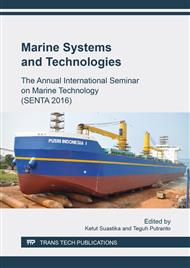p.10
p.18
p.27
p.37
p.44
p.53
p.64
p.71
p.81
An Analytical Approach to Modeling of Motion-Response of Floating Structure for Ocean Renewable Energy Conversion System
Abstract:
Ocean renewable energy research has been progressing well. Supporting structures are needed to convert energy from the sea. This paper discusses the response of the floating structure for ocean renewable energy conversion system by providing a simple design of floating structure. Due to its function, the system is limited for the pitching motion. By using the Lagrange formula, the equation of motion of the system can be obtained. In the analysis, there are three variations of wave period to determine the response of floating structure motion. The result shows the trend where the larger wave periods induce larger intersection angle (larger response) of the structure. The floating structure configuration for the ocean energy converter should be determined in such a way that have the most stable motion-response in any condition. The stability of floating structure will affect the current forces in the rotated turbine. It needs a specific design to hold the stability of floating structure.
Info:
Periodical:
Pages:
44-49
Citation:
Online since:
January 2018
Authors:
Price:
Сopyright:
© 2018 Trans Tech Publications Ltd. All Rights Reserved
Share:
Citation:


